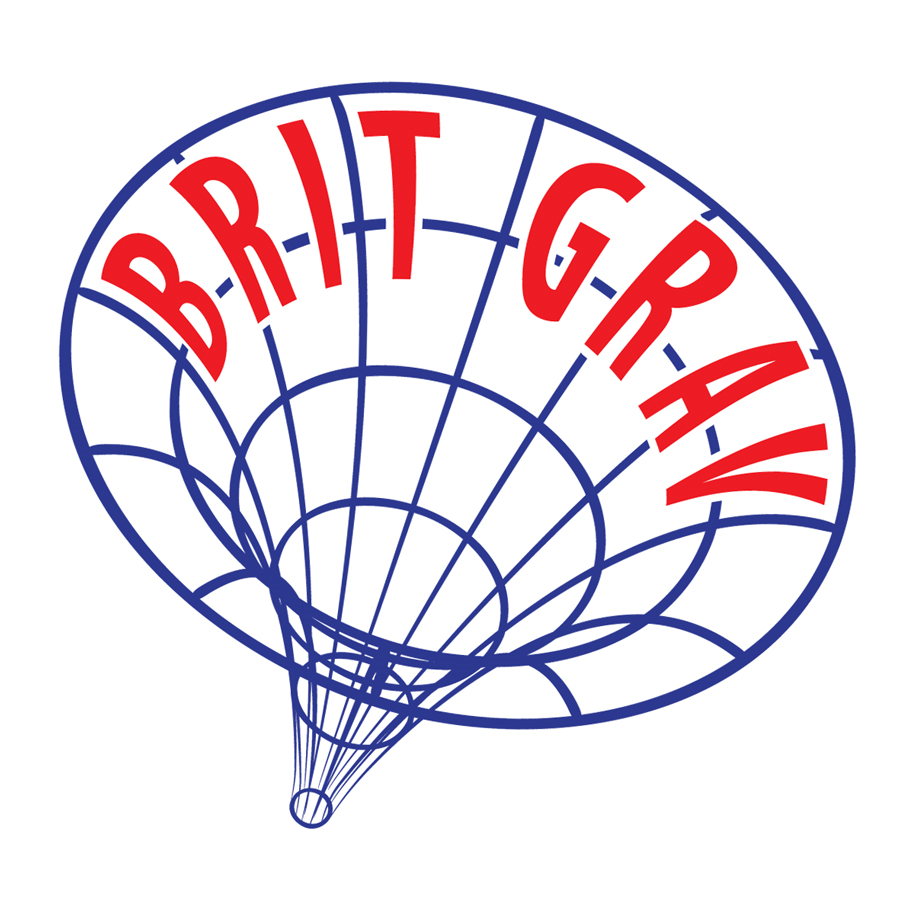 Programme and presentations from #BritGrav15 http://www.sr.bham.ac.uk/britgrav15/programme.php … pic.twitter.com/77Ffll8hgG
Programme and presentations from #BritGrav15 http://www.sr.bham.ac.uk/britgrav15/programme.php … pic.twitter.com/77Ffll8hgG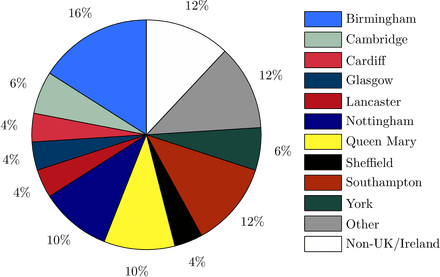 BritGrav 15April was a busy month. Amongst other adventures, I organised the 15th British Gravity (BritGrav) Meeting. This is a conference for everyone involved with research connected to gravitation. I was involved in organising last year's meeting in Cambridge, and since there were very few fatalities, it was decided that I could be trusted to organise...
BritGrav 15April was a busy month. Amongst other adventures, I organised the 15th British Gravity (BritGrav) Meeting. This is a conference for everyone involved with research connected to gravitation. I was involved in organising last year's meeting in Cambridge, and since there were very few fatalities, it was decided that I could be trusted to organise...- First up, Chris Collins talks is about testing gravity with the Inverse Square Law experiment. #BritGrav15
- The search for Newton's constantThree decades of careful experimentation have painted a surprisingly hazy picture of the constant governing the most familiar force on Earth.
- Haoyu Wang talks about talks about reducing thermal noise in Advanced LIGO #BritGrav15
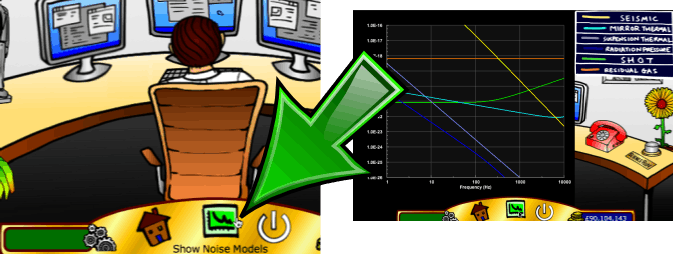 Space Time QuestDaniel Brown Paul Fulda Ludovico Carbone 2010 Have you ever wondered what it would be like to be in charge of a budget of £100 Million!? Have you ever wondered what it would be like to be the principal investigator on a continent spanning science project, with the aim of making one of the most important discoveries of the last 50 years!?
Space Time QuestDaniel Brown Paul Fulda Ludovico Carbone 2010 Have you ever wondered what it would be like to be in charge of a budget of £100 Million!? Have you ever wondered what it would be like to be the principal investigator on a continent spanning science project, with the aim of making one of the most important discoveries of the last 50 years!?- Josh Freedman on his masters' project modelling laser beam modes for Advanced LIGO #BritGrav15
- Duncan Meacher on a mock data challenge for the Einstein Telescope, a future gravitational-wave detector. #BritGrav15
 Einstein Telescopeadministrator The ET (Einstein Telescope) project aims to the realization of a crucial research infrastructure in Europe: a third generation Gravitational Wave observatory. ET has been supported as Design Study by thehis phase is concluded and a Conceptual European Commission under the Framework Programme 7 ( Design Document has been released; currently a new phase is open focused on the needed technologies development.
Einstein Telescopeadministrator The ET (Einstein Telescope) project aims to the realization of a crucial research infrastructure in Europe: a third generation Gravitational Wave observatory. ET has been supported as Design Study by thehis phase is concluded and a Conceptual European Commission under the Framework Programme 7 ( Design Document has been released; currently a new phase is open focused on the needed technologies development.- Meacher: ET detections out to max of z ~ 2. #BritGrav15
- Yiming Hu explains how we can be confident that we have actually made a gravitational-wave detection. #BritGrav15
- Hu: estimating noise background noise in LIGO difficult as we can't shield detectors from signals. Need network of detectors. #BritGrav15
- Alex Nielsen on detecting neutron star-black hole binaries with Advanced LIGO #BritGrav15
 Scientists: Collision of dead stars produced the world's gold - CNN.comAll that glitters is not gold, they say. But all the gold in the world may come from astronomical events that send a lot of high-energy light out in space. Researchers have new evidence that gold comes from the collision of neutron stars.
Scientists: Collision of dead stars produced the world's gold - CNN.comAll that glitters is not gold, they say. But all the gold in the world may come from astronomical events that send a lot of high-energy light out in space. Researchers have new evidence that gold comes from the collision of neutron stars.- Christopher Berry @cplberry talks about binary neutron stars measurements with Advanced LIGO #BritGrav15
- .@cplberry Chirp mass measured well even without spin. Sky area hundreds of square degrees http://arxiv.org/abs/1411.6934
- The First Two Years of Electromagnetic Follow-Up with Advanced LIGO and VirgoCatalog of simulated events and sky maps for two-detector, HL, 2015 configuration. This is the same configuration as the 2015, recoloured tab, except that the simulated detector noise is Gaussian. See also ASCII tables of simulated signals, detections, and parameter-estimation accuracies in Machine Readable Table format.
- Will Vousden @willvousden on speeding up parameter estimation with parallel tempering of MCMC: use a dynamical chain #BritGrav15
- .@willvousden: Dynamical chain gives a factor of a few improvement http://arxiv.org/abs/1501.05823 In process of testing for LIGO data. #BritGrav15
- Chris Moore on how to overcome uncertainty in waveform templates for Advanced LIGO parameter estimation. #BritGrav15
- Jade Poxwell @JadePowell12 on using gravitational waves to learn about supernovae collapse #BritGrav15
- .@JadePowell12 Uncertainty in supernovae waveforms. New paper on results this summer! #BritGrav15
- @BritGrav15 I'm not looking at uncertainty in the waveforms just using them to find explosion mechanism :-)
- Simon Stevenson @simon4nine talks about understanding the astrophysics of binaries: important for understanding gravitational waves
- Distinguishing population synthesis models using gravitational waves http://arxiv.org/abs/1504.07802 by @simon4nine, Ohme & Fairhurst
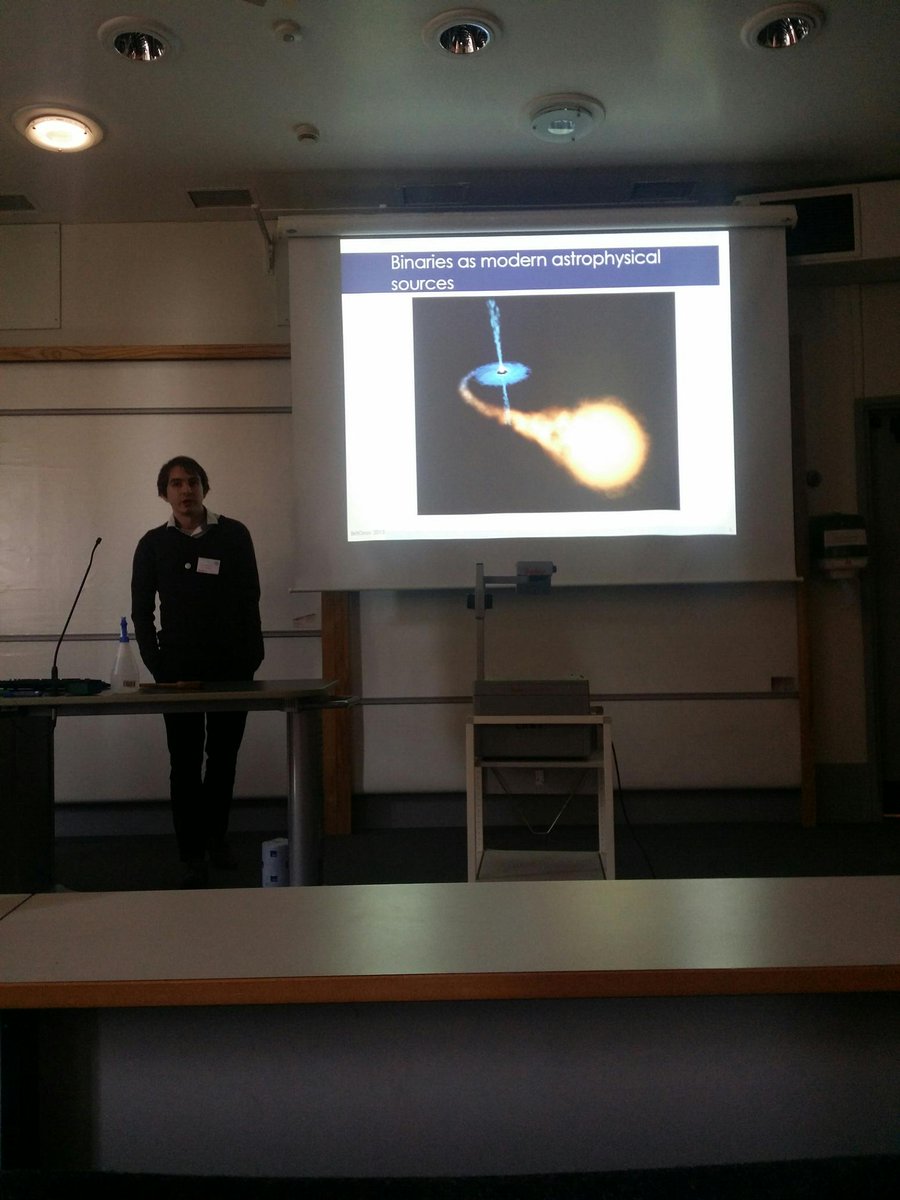 #Britgrav15 is off to a good start - 'black hole spin alignments' Simon Stevenson pic.twitter.com/iqG7rjFX0C
#Britgrav15 is off to a good start - 'black hole spin alignments' Simon Stevenson pic.twitter.com/iqG7rjFX0C- .@simon4nine Including spin precession of black holes adds info to waveform. It is an imprint of binary evolution #BritGrav15
- Could you tell direct collapse black holes from those via neutron star collapse? @simon4nine: Maybe via natal kick. #BritGrav15
- Hannah Middleton on using pulsar timing arrays to detect background of background gravitational waves from massive black holes #BritGrav15
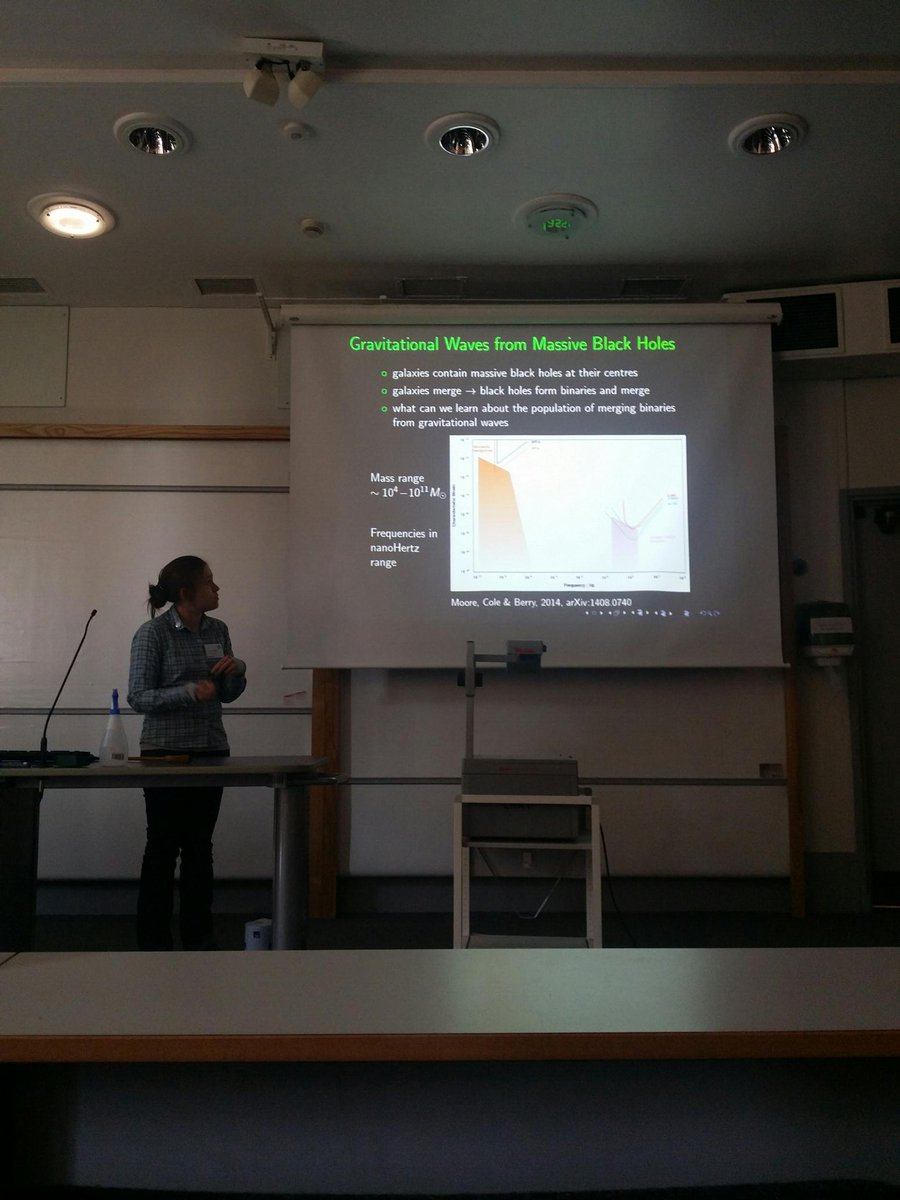 We need an array of pulsars to detect a stochastic gravitational wave background - Hannah Middleton #britgrav15 pic.twitter.com/qbaGuDv1Dl
We need an array of pulsars to detect a stochastic gravitational wave background - Hannah Middleton #britgrav15 pic.twitter.com/qbaGuDv1Dl- Middleton: What can a PTA upper limit tells us about black hole population? Not much about anything other than number density. #BritGrav15
- Middleton: Detection is more constraining! Frequency dependence could help constrain more physics. #BritGrav15
Session 3 (Chair: Hannah Middleton)
- Davide Gerosa on the most massive black holes in the Universe. Increase by a factor of 2 in mass since z = 2 by mergers #BritGrav15
- Gerosa: Undermassive BHs in BCGs indicates a larger number of mergers. A missing BH means a superkick from merger http://arxiv.org/abs/1405.2072
- Maggie Lieu @Space_Mog on weak lensing mass measurement of galaxy clusters, a useful probe for cosmology #BritGrav15
- .@Space_Mog: Use hierarchical modelling to describe population! Thanks @farrwill. Few assumptions & can include selection effects.
- Mateja Gosenca on general relativistic N-body simulations. Important for testing GR or including relativistic perturbations #BritGrav15
- Viraj Sanghai on constricting a post-Newtonian cosmological models #BritGrav15
- Sanghai: Obtain Friedmann-like equations. More details in http://arxiv.org/abs/1503.08747 #BritGrav15
- Gregory Ashton on periodic variability (timing noise) in pulsars. Precession or beam switching? #BritGrav15
- Vanessa Graber on the magnetic fields of neutron stars. Magnetars have fields of 10^15 G! #BritGrav15
- Graber: Need to consider vortex-flux tube interactions to get larger friction and shorter evolution timescale. #BritGrav15
- Graber: Large number of flux tubes (10^18 cm^-2) allows averaging for macroscopic properties. #BritGrav15
- Alice Harpole discusses type I X-ray bursts: explosive fusion in ocean of accreted material on neutron star #BritGrav15
- Harpole: Strong-gravity effects likely to be important, need to include in simulations. Can use low-Mach approximation #BritGrav15
- Harpole: Simulation http://www.southampton.ac.uk/~ah1e14/ only took 5 min on desktop using approximation! #BritGrav15
- Konstantinos Palapanidis on the inside of neutron stars. Strong interaction between proton and neutron fluids. #BritGrav15
Session 4 (Chair: Maggie Lieu)
- Weyl tensorIn differential geometry, the Weyl curvature tensor, named after Hermann Weyl, is a measure of the curvature of spacetime or, more generally, a pseudo-Riemannian manifold. Like the Riemann curvature tensor, the Weyl tensor expresses the tidal force that a body feels when moving along a geodesic.
- Jarrod Williams on the constant equations for numerical relativity calculations. These describe initial conditions #BritGrav15
- Gernot Heißel also on initial data. Current codes use wormhole data for black holes. These evolve to trumpets: start there! #BritGrav15
- Heißel: Presenting numerical derivation for Schwarzschild trumpet data as a guideline for Kerr. Matches analytical solution. #BritGrav15
- Heißel: Hopefully have Kerr initial trumpet data for next BritGrav! #BritGrav16
- William Cook on gravitational waves in higher dimensions. Simulations done in 5D. Building on that with new formalism. #BritGrav15
- Sebastian Khan on new gravitational waveform with inspiral, merger and ringdown plus precession! #BritGrav15
- Khan: PhenomD is frequency domain (fast). Calibrated against more waveforms. All matches better than 0.98! #BritGrav15
- Khan: PhenomD beats SEOBNR for large spins and high mass ratio. #BritGrav15
- Looking forward to PhenomD ! @NoWorkWednesday @BritGrav15
Session 5 (Chair: Chris Collins)
- To start off, Tedora Oniga on gravitational decoherence, which is still not well understood. #BritGrav15
- Spurgeon Talaganis on understanding loops in higher derivative gravity #BritGrav15
- Lisa Glaser on Hartle Hawking wave function in causal set quantum gravity. A lot for 10 min, she's going to speak quickly! #BritGrav15
- Jos Gibbons is talking about massless scalar fields, which he promises are really relevant for a gravitational conference #BritGrav15
- Gibbons: de Sitter space is interesting because of symmetry and because the universe is falling up (accelerating) #LittleBritGrav
- Gibbons: More details in our paper http://arxiv.org/abs/1410.7830 Still working on gravity calculations #BritGrav15
- Ilia Musco will give us the latest results regarding quasi-static solutions for compact objects in Chameleon models #BritGrav15
- Musco: Chameleon mechanism screens scalar fields so it can explain dark energy and evade local measurements. #BritGrav15
- Musco: Universal solution for incompressible star, central scalar field depends on compactness M/R and coupling strength #BritGrav15
- Mattia Colombo on Horava gravity. Results in http://arxiv.org/abs/1410.6360 and http://arxiv.org/abs/1503.07544 #BritGrav15
- Aindriú Conroy explains the Raychaudhuri equation before what it means to be geodesic incomplete. #BritGrav15
Session 6 (Chair: Will Farr)
- Christian Luebbe on conformal cyclic cosmologies (CCC). He'll be using conformal scalar fields. #BritGrav15
- Luebbe: Can use conformal scalar field (CSF) to map aeons. Does CSF control inflation? Are there applications in AdS/CFT? #BritGrav15
- Leithes: For 1st time, evolution of stable perturbations in 2 fluid, 2 field, sum of exps model. Papers for PYESSENCE soon #BritGrav15
- Adam Christopherson @AJChristo is interested in axions, a potential candidate for dark matter. #BritGrav15
- .@AJChristo: Modelling axion as a classical field with Schroedinger-Poisson equations. This reproduces homogeneous background. #BritGrav15
- .@AJChristo: Need inhomogeneities for structure formation. Linear Newtonian perturbations reproduced from Schroedinger-Poisson equations!
- Linear Newtonian perturbation theory from the Schrödinger-Poisson equations by Banik @AJChristo Sikivie & Todarello http://arxiv.org/abs/1504.05968
- Brien Nolan is going to tell us about his favourite spacetime: McVittie (embedding of Schwarzschild in FRW) #BritGrav15
- Nolan: Class 1, with cosmological constant: can extend across r = 2m to Schwarzschild-de Sitter. More like a black hole! #BritGrav15
- Nolan: Does black hole or expansion win? Depends where you are, stable orbits are possible. #BritGrav15
- Matthew Wright on a solution for slowly rotating perfect fluids with a cosmological constant http://arxiv.org/abs/1411.5486 #BritGrav15
- Edgar Gasperín on conformal geometry. Analysing extremal Swarzschild-de Sitter #BritGrav15
- Michael Cole will be telling us about Killing spinors. Killing spinors tell us about properites (Petrov type) of spacetime #BritGrav15
- Cole: In electrovacuum, trying to find Killing spinor. Could evolve integrability condition with suitable initial conditions #BritGrav15
- Cesar Merlin wants to find extreme mass-ratio inspiral gravitational waveforms http://arxiv.org/abs/1310.1513 http://arxiv.org/abs/1410.2998 #BritGrav15
Session 7 (Chair: Simon Stevenson)
- David Dempsey on the bound states of the Dirac equation in Kerr http://arxiv.org/abs/1504.03190 A black hole hydrogen atom #BritGrav15
- Dempsey: Tested analytic results and found new features at critical frequency. Next, looking at hyperfine structure. #BritGrav15
- Dempsey: Tested analytic results and found new features at critical frequency. Next, looking at hyperfine structure. #BritGrav15
- Vladimir Toussaint on a particle detector in a cylindrical spacetime where there is no privileged vacuum state. #BritGrav15
- Toussaint: Simplest detector: a 2-level quantum system. Can distinguish two spin structures by zero mode. #BritGrav15
- Benito Juárez-Aubry is going to talk about quantum effects at a Cauchy Horizon, but not Gandalf. #BritGrav15
- Juárez-Aubry: Respect causality and don't do near a Cauchy horizon! #BritGrav15
- Hugo Ferreira wants to calculate local observables for a rotating black hole background (using a quasi-Euclidean method). #BritGrav15
- Supakchai Ponglertsakul is looking at black hole solutions in Einstein-charged scalar field theory. #BritGrav15
- Ponglertsakul: What could be the end point of instabilities? Hairy black holes found numerically. These seem stable. #BritGrav15
- Yafet Sánchez Sánchez: general relativity predicts its own breakdown through the presence of singularities. #BritGrav15
- Bernard Kay on black holes in a box (not an astrophysical black hole… ) #BritGrav15
- Umberto Lupo also thinking about black holes in a box http://arxiv.org/abs/1502.06582 Is there a description of thermal equilibrium? #BritGrav15
Session 8 (Chair: Alberto Vecchio)
- 2014 Thesis Prize Winner Anna Heffernan
- First @PhysicsNews prize talk: Anna Heffernan, The Self-Force Problem #BritGrav15
- Announcement about Anna's prize here: http://cqgplus.com/tag/gpg-thesis-prize/ …
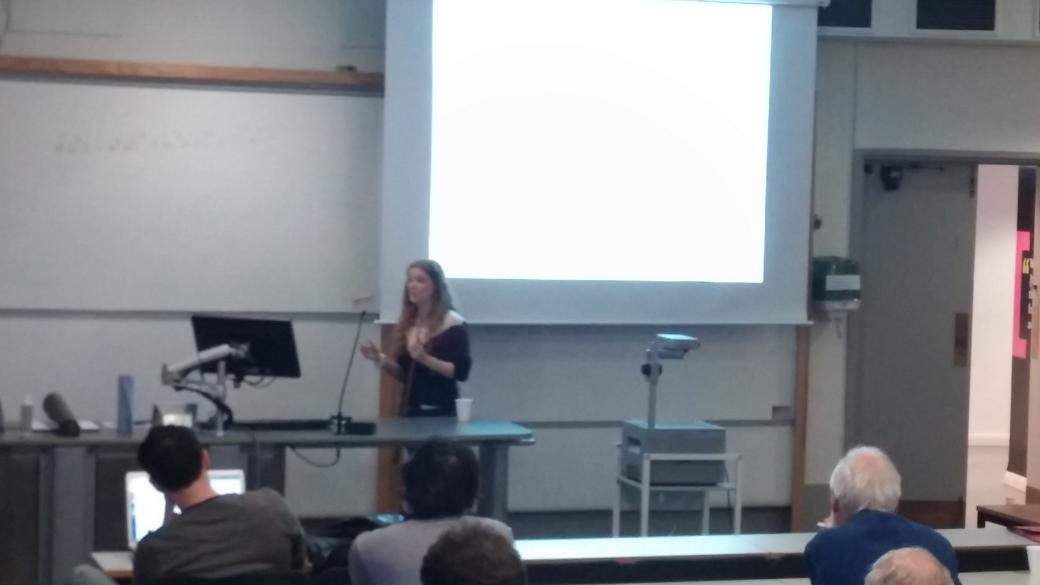 Anna Heffernan's GPG thesis prize talk @BritGrav15 (prize co-sponsored by #CQG) pic.twitter.com/rOpDL5mORg
Anna Heffernan's GPG thesis prize talk @BritGrav15 (prize co-sponsored by #CQG) pic.twitter.com/rOpDL5mORg- Heffernan: Need self-force for extreme mass-ratio inspirals (EMRIs), a gravitational-wave source for eLISA! See http://rhcole.com/apps/GWplotter/
- Heffernan: Singular field doesn't look nice when written down, but makes some pretty plots! (Slide 28: http://www.sr.bham.ac.uk/britgrav15/slides/session8/02_AnnaHeffernanBritGrav15.pdf …)
- Heffernan: Need to be careful subtracted infinities. Will use mode-sum regularization with cunning coordinate choice. #BritGrav15
- Heffernan: Using this improvement in self-force calculations, others went on to investigate ISCO, etc. #BritGrav15
- Heffernan: Looked at effective source method as alternative to mode-sum. More pretty pictures on slide 56 ( http://www.sr.bham.ac.uk/britgrav15/slides/session8/02_AnnaHeffernanBritGrav15.pdf …)
- Heffernan: No EMRI waveforms as yet. Need more accurate Kerr results, 2nd order terms and orbit evolution. #BritGrav15
- Heffernan: Lots of thesis highlights. It went well! [Applause] #BritGrav15
- Dolan: Recent work on identifying gauge-invariant quantities instead of going directly for waveforms. #BritGrav15
- 2015 Thesis Prize Winner Patricia Schmidt
- This year's winner Patricia Schmidt: Modelling Precessing Black Hole Binaries. #BritGrav15
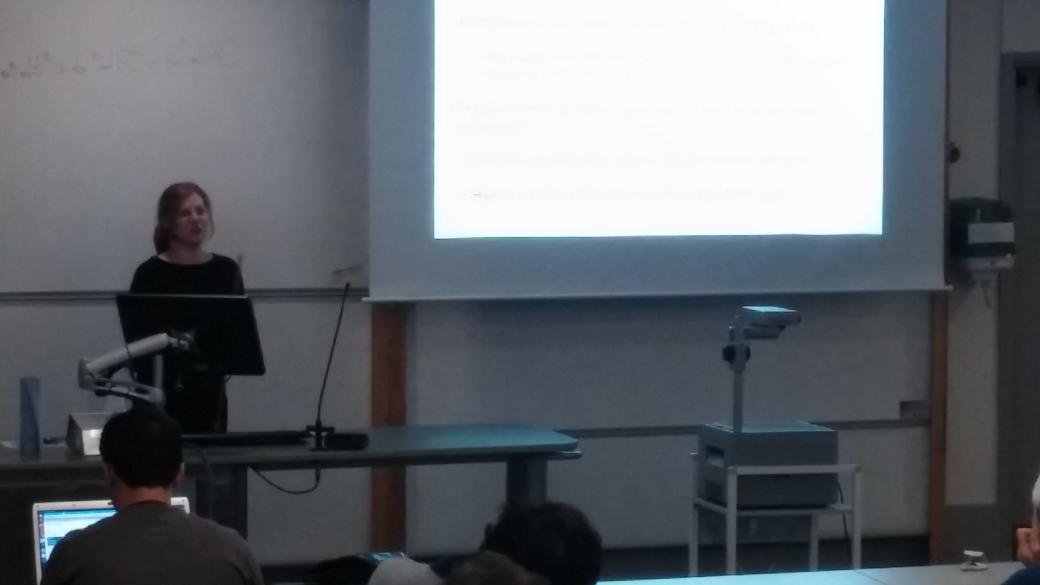 Patricia Schmidt gives the second GPG thesis prize talk of the day. @BritGrav15 pic.twitter.com/5ryge3XHQX
Patricia Schmidt gives the second GPG thesis prize talk of the day. @BritGrav15 pic.twitter.com/5ryge3XHQX- Interview with Patricia Schmidt, 2015 GPG thesis prize winner http://wp.me/p47IEi-gg via @PublisherAD
- Schmidt: Want inspiral-merger-ringdown (IMR) waveforms for detection and parameter estimation in advanced detection era. #BritGrav15
- Schmidt: Tracking of orbital plane difficult in GR: use direction of dominant emission direction. #BritGrav15
- Schmidt: Have removed precession! Now use inverse procedure to make precessing waveforms: do the twist! #BritGrav15
- Schmidt: Over many precession cycles, can use average of spin. Checking match shows reduced spin parameters work. #BritGrav15
- Schmidt: End product is IMRPhenomP http://arxiv.org/abs/1308.3271 #BritGrav15
- Are we limited by lack of numerical waveforms to check against? Schmidt: Parameter space is huge. Work being done to explore. #BritGrav15
- Best Student Talk Prize
- #BritGrav15 best student talk prize sponsored by #CQG… Runners up Viraj Sanghai & Umberto Lupo. Winner: Christopher Moore! Congratulations!
- Thanks to John Miller, Carsten Gundlach & John @JohnVeitch for judging, and for @PublisherAD for the prize! #BritGrav15
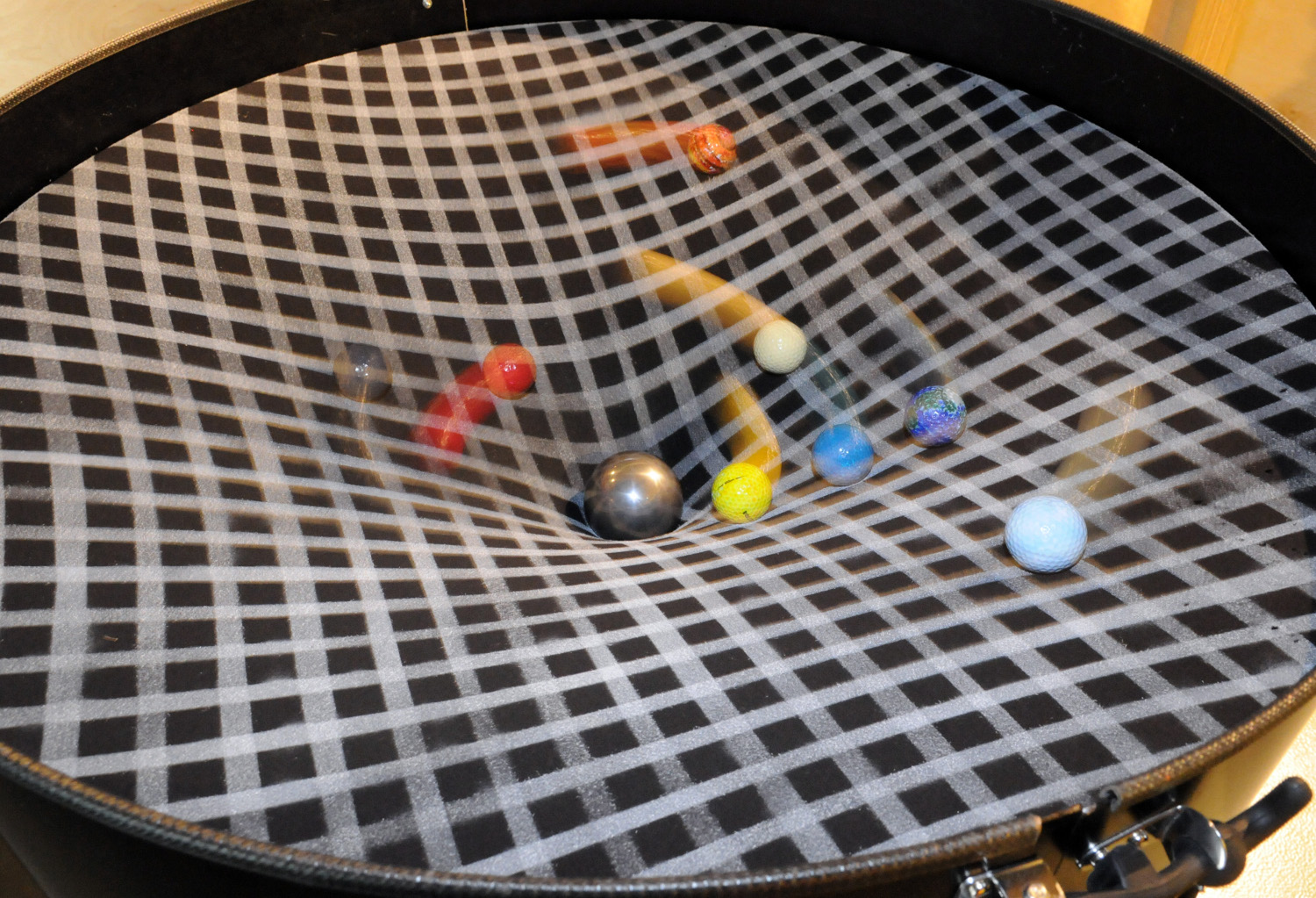 BritGrav 15 | BirminghamFollowing the close of the conference, we will be holding a public lecture. Prof. Jim Hough from the University of Glasgow's Institute for Gravitational Research will give a guest talk on the science of gravitational-wave detection and what to look forward to in 2015.
BritGrav 15 | BirminghamFollowing the close of the conference, we will be holding a public lecture. Prof. Jim Hough from the University of Glasgow's Institute for Gravitational Research will give a guest talk on the science of gravitational-wave detection and what to look forward to in 2015.


